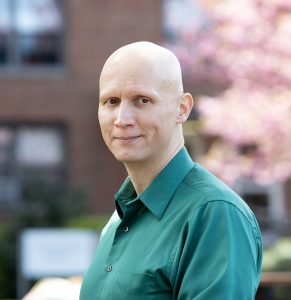
Adelphi social work professor advocates for better practices and policies after shocking statistics on suicide come to light.

Geoffrey Ream, PhD
In 2019, Geoffrey Ream, PhD, professor of social work at Adelphi, published “What’s Unique About Lesbian, Gay, Bisexual, and Transgender (LGBT) Youth and Young Adult Suicides? Findings From the National Violent Death Reporting System” (Journal of Adolescent Health, May 2019), which explores variability in circumstances around LGBTQ+ youth suicides by identity group. He drew on years of data released by the CDC’s National Violent Death Reporting System (NVDRS), which revealed the sobering reality that 24 percent of 12- to 14-year-olds who died by suicide nationwide were LGBTQ+.
Since then, Dr. Ream and his colleague Andrew Peters, director of Adelphi’s Manhattan Programs for the School of Social Work, have worked to translate these findings into social work practice and policy recommendations. The resulting article, “Working With Suicidal and Homeless LGBTQ+ Youth in the Context of Family Rejection,” appeared in the Journal of Health Service Psychology in February 2021.1
Family rejection—which includes expulsion, violence, name-calling, nonphysical punishment and ignoring—is a particularly acute risk factor for LGBTQ+ youth suicide. When working with difficult families, Dr. Ream and Peters write, “clinicians should probe for what parents know about LGBTQ+ people, correct prejudices and misinformation, and contextualize … often they will need to be flexible in order to meet the family ‘where they are.'” Some families will be open to making small changes, such as agreeing to refer to transgender youth by their chosen name, but others may remain intransigent. In those cases, Peters notes, a social worker can pursue other avenues.
“Children really need supportive, affirming adults in their lives who genuinely care about them,” Peters said. “A social worker or mental health counselor can certainly be one of those people, and they can also help the youth make other important connections: an older sibling, aunt or uncle, teacher or coach. LGBTQ+ youth community centers also offer opportunities for mentoring, recreation and peer support.”
Even so, family rejection can easily lead to homelessness. Peters recalled, “I’ve had clients whose families changed the locks on their homes, leaving their son or daughter to fend for themself. Some teens end up in homeless shelters and/or foster care. Often, there aren’t realistic options for family unification.”
Once they become homeless, LGBTQ+ youth are at the mercy of what Dr. Ream and Peters call a “patchwork quilt of services.” LGBTQ+-friendly clinicians, the child welfare system and transitional housing programs, already scarce commodities, become much harder to access over the age of 18. “Any transition, including the eventual one to independent living, also comes with a risk that they will lose access to the case managers and clinicians who knew their situation,” the authors write. “Disruption in clinical services is risky for someone coping with suicidality.”
According to Peters, disruption can be mitigated simply by increasing resources. “We need more beds in youth homeless shelters and more transitional living programs (those for young people who need longer-term housing),” he said. “We need more case managers to help young people navigate the complex network of public and private community-based organizations that provide many terrific services, from basic needs like food to GED and college portal programs.” Ultimately, however, the most effective short-term solution is the simplest, Dr. Ream explains. “A homeless young person is often best served by being able to go back home, and a suicidal young person is often best served by the family being engaged in trying to get them help.”
While Dr. Ream readily concedes that the current system is far from ideal, he does have one pragmatic policy suggestion: “Take the services and infrastructures we already have and make sure they have the resources they need.” The focus, he believes, should be on creating support systems that are strong enough to pass from one generation to the next. “It’s possible to get a lot of attention to a problem for a time or a season,” he said, “but it’s hard to keep the public’s attention on a problem long enough to meaningfully address it.” The head-turning NVDRS data, he maintains, brings us one step closer toward preserving that attention.
Footnote:
1 Ream, G., and Peters, A. “Working With Suicidal and Homeless LGBTQ+ Youth in the Context of Family Rejection.” Journal of Health Service Psychology, vol. 47, February 2021, pp. 41-50.